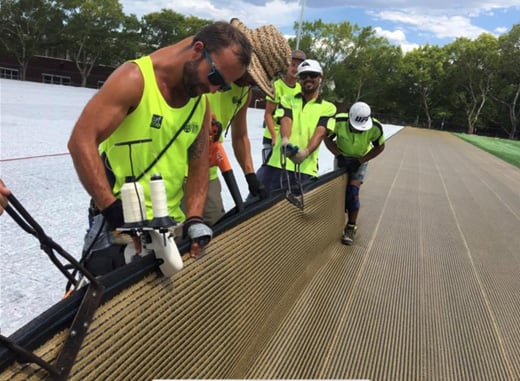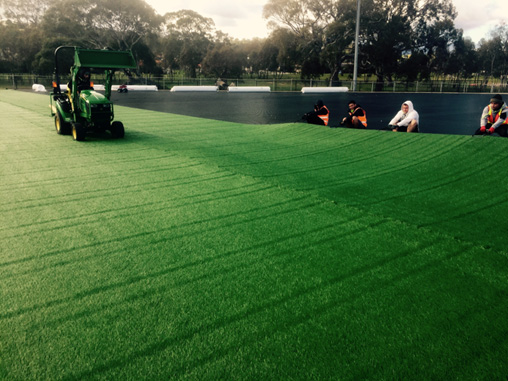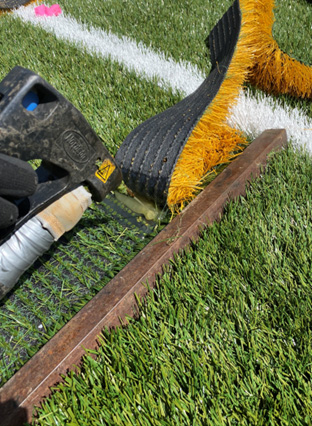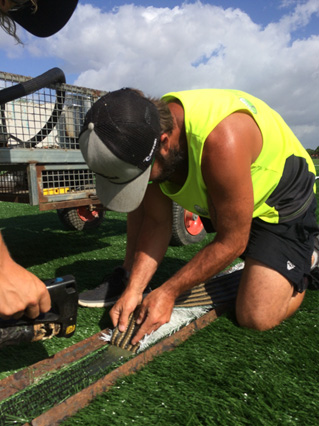There are traditionally two methods when laying synthetic grass on a sports field: Tape and glue seams or sewn seams.
In our fifth synthetic turf web series episode, our Synthetic Grass Specialist Andrew Morrow explains the differences between these two methods and which one should be considered for which sport.
The most common method is using rolls of tape and glue to join synthetic turf rolls.
This first method consists of laying out the synthetic carpet rolls side by side ( for soccer fields, approx 60m x 3.66m rolls) and positioning the rolls in the correct field position.
Once the rolls are in position, the adjoining edge of the two rolls are opened up and folded back, allowing a gap. One method is to lay a 300 – 450mm jointing tape along the gap and trowel adhesive over the tape. The two edges of the synthetic grass rolls are folded back over adhesive and tape, and with a small hand roller, the synthetic grass is pushed into the wet adhesive to ensure a good bond.
The same glued system can also be installed by placing synthetic rolls side by side and folding them back along the join. At one end of the roll, set up a “glue boat” ( container adhesive and frame to hold a roll of jointing tape) The roll of jointing tape is pulled through the glue boat, where the adhesive is applied and laid out along the gap between the two rolls of synthetic turf. Once again, the two edges of synthetic grass are folded back and butted up against each other and pushed into the wet adhesive with a hand roller.
The weather conditions play a big part in the success of this method. Cold temperatures ( < 15°) and moisture effects the ability to apply the adhesive and cure the adhesive.
Sewing synthetic grass seams together.
This second method is considered a stronger result than a glued system!
This method consists of a sewing machine that stitches the grass together. It does require more people to perform the task, but can be undertaken throughout the year and in damp conditions. The method of sewing two synthetic grass rolls is undertaken by laying two synthetic grass out side by side, and then one is flipped over to lay upside down on the other roll. Holding both rolls up by the seam, the two edges are sewn together like you would for two pieces of fabric.
 Sowing seams of synthetic grass
Sowing seams of synthetic grass
Once the length is completed, the top roll of grass is laid back over, with the grass now facing upwards. This process is repeated, with the roll of grass laid upside down on the recently sewn roll.
 Rolls are flipped over, and seam flattened
Rolls are flipped over, and seam flattened
This methodology is predominately used for long pile synthetic grass, i.e. 50mm – 70mm, not used for tennis SFAG or hockey fields.
What about the sports fields’ lines?
For most fields/courts, efforts are made to stitch the sports lines into the product, so when the grass is rolled out, the white lines sit exactly where they’re supposed to.
The manufacturer produces a roll layout, which calculates the most efficient and cost-effective number of synthetic grass rolls. As part of this layout, lines that can be manufactured (stitched) into the grass roll are shown. The aim is to optimise the number of lines that can be stitched in as part of the manufacturing process. This saves time during installation and also provides a stronger installation.
Installing lines can be undertaken by two methods :
Once all the synthetic grass rolls have been installed, the lines are marked out, and the width of the roll is cut out of the grass. A strip of grass and backing is completely removed, and a synthetic grass-coloured strip of grass is installed by the adhesive and tape method.
However, cutting through the backing and gluing in the lines potentially provides weak spots in the synthetic grass field. The more cuts there are, the greater the probability of a tear or split occurring.
The second method of installing lines is by shearing off the green synthetic grass fibre down to the backing at the width of the line.



Photos from left to right: Shearing fibre; Hot melt glue; Installing lines with hot melt glue.
A strip of coloured synthetic grass is then glued onto the exposed backing, completing the installation of the line. The benefit of method 1 is less of the backing is cut through, thus fewer potential weak areas within the field.

